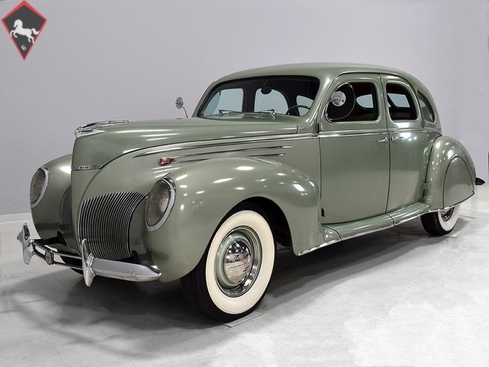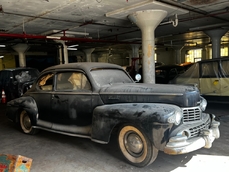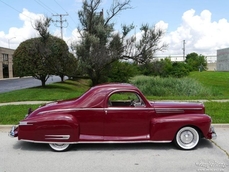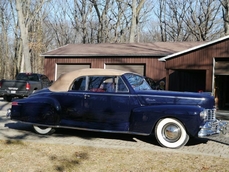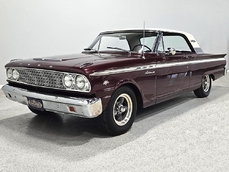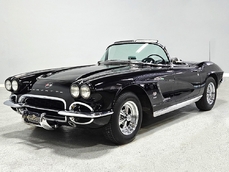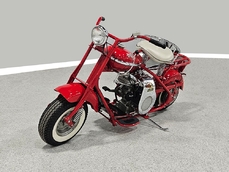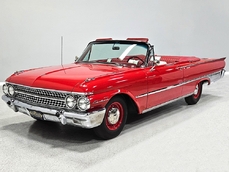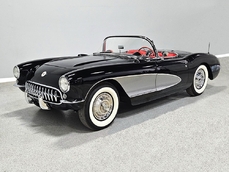Lincoln Zephyr 267 cubic inch V12 1939
Allgemeine Beschreibung :
There's only one word to describe this 1939 Lincoln Zephyr: stunning. The pinnacle of Lincoln's Art-Deco styling, many enthusiasts argue that the 1939 Zephyrs represent the purest expression of the aerodynamic movement. From the graceful waterfall grille derived from the all-new Continental to the tapered tail originally envisioned by its designer to hold a rear-mounted engine, there's just not a bad line anywhere on this car. Ostensibly Lincoln's "junior" model, the Zephyr was a scene-stealer everywhere it went and today represents perhaps the biggest value in '30s luxury collectables. Where else will you find a car with twelve cylinders, overdrive, and such dramatic styling, all for under $40,000? If you view the automobile as art, nothing will help you make your case better than the Lincoln Zephyr.
This particular 1939 Zephyr sedan is a wonderfully well preserved car that has been restored and freshened as needed, but never fully restored. The soft metallic green is its original color, called Arden Green, and we have to admit that it's exactly the right choice on the curvaceous Zephyr bodywork. It has been repainted once and touched up since then, but we can find no evidence of previous bodywork or damage and it fits together extremely well. There’s a soft shine to the paint that suggests it might be lacquer or even enamel and it’s very appropriate on the late ‘30s curves. Where Chrysler was perhaps too soon with their aerodynamic Airflow, this Zephyr looks right in every possible way. You may find yourself standing back to admire the car and finding new little details that delight the eye: the oval-shaped wind wings, the graceful curve of the grille’s leading edge, the simple hood ornament with built-in hood latch, and the way the fender skirts echo the body’s profile. The Zephyr’s design is often credited to Bob Gregorie, but it was actually penned by John Tjaarda, a stylist at Briggs Manufacturing who was fascinated with aircraft and envisioned this as a rear-engined car similar to the Tatra. At Edsel Ford’s request, Gregorie took the design and made it compatible with the V12 Lincoln chassis. The result is one of the most beautiful cars you’re likely to see. If this car doesn’t make your heart race, you might not be human.
Much of the chrome and stainless trim is original, but it’s in fantastic condition. There might be some very, very minor pitting on the pot metal parts such as the grille, but it requires a VERY close examination to see any of it. It’s possible that the bumpers have been re-chromed, perhaps when the car was repainted, so it has a consistent, all-of-a-piece look that works extremely well. Perfectionists might want to stay away, but for everyone else, this is a fantastic find.
We strongly believe the interior is largely original and in incredible condition. The seats have not been reupholstered—we believe those are seat covers, perhaps installed when the car was new and fitted so tightly over the seats that they look like upholstery. However, you can clearly see the original pleats underneath. We have not investigated the condition of the upholstery under the covers, a treat we’ll leave to the next lucky owner, or perhaps you simply leave it alone because it looks rather handsome as-is. The original wool broadcloth door panels are in exemplary condition and it’s possible that even the carpets are factory-issue, it’s hard to say. They’re old but not deteriorated or soiled. The ’39 Zephyr features one of the most wonderful instrument panels of the period, a tower in the center of the dash topped by a massive speedometer that also houses the secondary gauges. This could be one of the earliest instances of a center console, and it’s cleverly designed to accommodate the shifter as it snakes out from behind. It looks odd but works just fine and feels instantly familiar. All the gauges are fully operational and the clock ticks away reliably. Only the steering wheel shows signs of age, with the usual cracking although none of it has fallen off and I’m not sure I’d be in a hurry to restore it. The car includes accessories such as an AM radio (not functional, sadly), a gas-fired South Wind heater under the dash (the fan is operational, but we have not fired it), and a cooling fan mounted on the steering column. At some point, someone has added turn signals to the car, and that’s a worthy safety upgrade. The backseat area is quite spacious and shows few signs of use and all that space would make this a first-rate touring car. And despite the steeply raked rear deck, there’s a surprisingly spacious trunk inside, complete with a working trunk light and spare tire assembly that effortlessly tilts out of the way on spring-loaded hinges.
The Zephyr’s V12 was all-new when the car debuted in 1936 and is more closely related to the flathead V8 than the K-Series engines. With 267 cubic inches, it isn’t a massive torque factory but it does offer impeccable smoothness and near bulletproof reliability. Rumors and legends of these being finicky engines that are prone to overheating are likely derived from neglected examples, because the proven hardware works rather well in the Ford V8. At any rate, this one retains its original aluminum cylinder heads, which obviously help with cooling, and it springs to life with just a bit of choke. There’s an electric fuel pump in the rear of the car to help with priming, but once it’s running, the mechanical pump takes over and it works as it should. The engine was obviously removed from the car and properly detailed and we have receipts and photos of it being rebuilt in 1978 using parts from the legendary Earle O. Brown. It can’t have many miles since then and today it makes 40 pounds of oil pressure at idle, it doesn’t smoke or make strange noises, and has a buttery-smooth idle that twice made me believe the car had stalled. Impressive.
’39 Lincoln Zephyr transmissions were prized by hot-rodders for their closer ratios and the shift quality on this Zephyr is excellent with no clashing or balkiness. Clutch take-up is smooth and thanks to a Columbia 2-speed rear end, this Zephyr is a fantastic high-speed tour car that’s quite happy at 65 MPH. As a car where the body has never been off the frame, it’s a bit grungy underneath but there are no signs that this car ever spent time in the harsh winter weather. The bare metal floors are in good order, the outer rocker panels show no signs of rot, and there’s plenty of evidence of proper maintenance over the years, including a newer transverse muffler in back. The recent electric fuel pump has a built-in regulator that primes the system then turns itself off until needed. Nice! The Columbia 2-speed is operational, although we prefer to simply leave it in high range, and the brakes were recently and extensively serviced with new hoses, wheel cylinders, and shoes. Lincoln was still using a beam axle up front, so it’s not sophisticated, but steering effort is light and the car goes down the road straight, even on the bias-ply tires. Those are 7.00-16 Firestone wide whites of indeterminate age and they’re mounted on the original wheels with Zephyr hubcaps and trim rings.
There is a MASSIVE documentation package on this car as well. It has its original reference manual, which was apparently mailed to the first owner, Ernest A. Sinton in Colorado Springs, Colorado, as well as a service book for the Columbia rear end, a chassis parts manual, and an original repair manual for the V12 engine. There are also dozens of period advertisements, paint charts, and catalogs from various Lincoln parts suppliers. We also have titles dating back at least to the 1970s when the car was in Oklahoma before heading to Pennsylvania sometime before the 1978 engine rebuild. There’s a rather large box of paperwork, so you’ll enjoy spending an afternoon sifting through this car’s awesome history.
This is a wonderful car, that’s the long and the short of it. It’s simply stunning just sitting in your garage and the road manners, particularly with the 2-speed rear end, make it a fantastic tour car. The combination of known history and sympathetic but not complete restoration make it a wonderful artifact for the person who likes his car to have a bit of history behind it. This is another car that we would very much like to add to our personal collection, but perhaps you’ll be fast enough to take it home before I truly fall in love. Call today!
http://www.harwoodmotors.com/vehicles/inventory_details.php?id=877
1939 Lincoln Zephyr 267 cubic inch V12 is listed verkauft on ClassicDigest in Macedonia by for $37900.
Fakten der Auto
Karosserietyp : Auto Marke : Lincoln Modell : Zephyr Ausführung : 267 cubic inch V12 Hubraum : 0.0 Modelljahr : 1939 Karosstyp : Sedan Lage : Ohio
Verkauft
Angaben Zum Verkäufer
Verkauft
People who viewed this Lincoln Zephyr also viewed similar Lincoln listed at ClassicDigest
Other cars listed for sale by this dealer
über Lincoln
Lincoln, oft mehr als nur ein gehobenes Ford betrachtet, hat sich mit einer reichen Geschichte und einer Auswahl von unverwechselbaren Modellen einen eigenen Platz in der Automobilwelt geschaffen. Lassen Sie uns einen Spaziergang durch die Erinnerungen der Geschichte von Lincoln machen.Die Anfänge:
Gegründet im Jahr 1917 von Henry Leland, dem Mann hinter der Marke Cadillac, begann Lincoln zunächst als Luxus-Automobilunternehmen. Die Marke gewann schnell einen Ruf für ihre hochwertige Handwerkskunst und Liebe zum Detail.
Die Ford-Ära:
Im Jahr 1922 wurde Lincoln von der Ford Motor Company übernommen, und dies markierte den Beginn einer langen Partnerschaft. Ford wollte Lincoln als seine Luxusdivision positionieren und mit anderen renommierten Marken auf dem Markt konkurrieren.
Klassische Modelle:
Im Laufe der Jahre hat Lincoln mehrere ikonische Modelle eingeführt, die einen bleibenden Eindruck auf die Automobilwelt hinterlassen haben:
Lincoln Continental: In den 1940er Jahren eingeführt, wurde der Continental sofort zum Klassiker. Sein elegantes Design und die ikonischen Selbstmördertüren machten ihn zu einem Symbol für Luxus und Raffinesse.
Lincoln Town Car: In den 1980er Jahren eingeführt, wurde der Town Car gleichbedeutend mit chauffeurgetriebenem Luxus. Sein geräumiges Interieur und die sanfte Fahrt machten ihn zu einem Favoriten unter Führungskräften und Würdenträgern.
Lincoln Navigator: Ende der 90er Jahre erlebte die SUV-Begeisterung ihren Höhepunkt, und Lincoln reagierte schnell mit dem Navigator. Als Full-Size-Luxus-SUV kombinierte der Navigator Opulenz mit Nutzwert und wurde zu einer beliebten Wahl unter wohlhabenden Familien.
Die Renaissance des Navigators:
Die neueste Generation des Lincoln Navigator, eingeführt im Jahr 2018, war ein entscheidender Akteur im jüngsten Erfolg der Marke. Die Kombination aus kühnem Design, einem üppigen Interieur und modernster Technologie hat den Status von Lincoln im Luxus-SUV-Segment erhöht.
Ausblick:
Lincoln entwickelt sich weiter und konzentriert sich darauf, eine personalisierte und mühelose Besitzerfahrung zu schaffen. Mit einem Schwerpunkt auf Luxus, Innovation und unverwechselbarem Design ist Lincoln bereit, die Zukunft mit einer Mischung aus Tradition und zeitgenössischem Flair zu gestalten.
